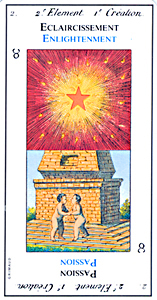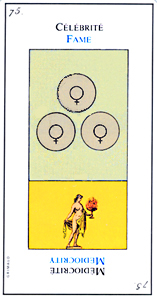

For Etteilla, the integration of Tarot and astrology was natural; he used both divinatory sciences in his practice as a spiritual advisor or consultant.26 To merge the two he, in part, assigned selected astrological concepts to selected cards, including the twelve signs of the Zodiac which he associated with twelve Trumps (see Appendix A). For example, he associated �claircissement [Enlightenment] (which corresponds to the Sun of more traditional decks) with Taurus; therefore, the symbol for this sign appears in the upper left and lower right of this card from Etteilla�s deck (see Figure 2). In addition, he assigned planetary and related astrological concepts to the numeric cards (Ace through Ten) of the suit of Coins (see Appendix B). For example, he associated Venus with the Three of Coins; therefore the symbol for this planet (on the three coins) and an image of the goddess Venus appear on this card (see Figure 3).
Etteilla fails to explain clearly his method for assigning correspondences; however, one may reasonably deduce it in part. Drawing upon the Pymander,27 a mystical, Hermetic text from late antiquity, Etteilla consciously revised the traditional Tarot de Marseille to reflect clearly his view of the cosmos and its creation. Thus the first Trump, which pictured the Void (not a Sun as on the modern Grimaud version of his deck) depicts that Chaos which preceded the Creation.28 Next, Trumps two through seven depict the story of Creation. Etteilla also assigns the four traditional Elements, the basic building blocks used by the Creator, to Trumps two through five; and the Zodiacal signs, the basic celestial structure established by the Creator, to Trumps two through fifteen. Finally, to complete his view of the cosmos he assigned the planets and other astrological concepts to the numeric cards of the suit of coins, which he and some other Tarotists29 have considered the lowest ranking cards. His order for the planets and other astrological concepts was logical: he began with the Sun at the center of the solar system, worked his way out to Saturn, the outermost known planet, and completed the series with the Lunar Nodes and Pars Fortunae (Part of Fortune) as �shadow� planets. Thus, Etteilla�s Tarot encompassed the known cosmos, from the Trumps, which included the fixed stars of the Zodiac, down to the numeric cards of the suit of coins, which included the planets.
Of course, Etteilla�s correspondences differ from those later espoused by the L�vi,30 Papus31 , 32 and the Hermetic Order of the Golden Dawn;33 however, agreement among all Tarotists concerning correspondences has long been elusive. In fact, after summarizing and comparing numerous systems, Bayard wrote, �What conclusion does one draw from these comparisons? It is extremely difficult to determine the affinity between the cards and astrological signs. Each system has its drawbacks and advantages which are peculiar to it.�34
With regard to divination, Etteilla advocated a specific method which integrated Tarot and astrology and included a spread based on the twelve Zodiacal houses.35 , 36 , 37 However, unlike any twelve-house spread recommended in typical occultist and popular literature38 or known to the authors, Etteilla�s has the advantage of producing a horoscope, i.e., a chart which depicts planetary and other astrological phenomena in specific Zodiacal houses, which may be interpreted according to astrological conventions.
Although the historic record is apparently silent on the matter, presumably Etteilla�s students did use his correspondences. Still, multiple leading occultists, including Christian,39 Papus,40 , 41 and Wirth42 would reject Etteilla�s integration in favor of their own or others. Occultists who adhered to, or were significantly influenced by formal teachings of the Hermetic Order of the Golden Dawn,43 , 44 such as Mathers,45 Crowley,46 and Case,47 did likewise. However, all were indebted to Etteilla to the extent that he pioneered the merger of Tarot and astrology. The next part of this article describes Etteilla�s method of applying his integration of Tarot and astrology to divination. Where it has occasionally been adapted, the authors so note.